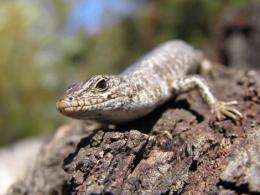Lizard sex linked to climate

(PhysOrg.com) -- A Tasmanian lizard has evolved to give birth to more male or more female offspring depending on climatic conditions, Oxford University scientists have discovered.
The snow skink (Niveoscincus ocellatus) is a small lizard that lives in both the warm lowlands and cooler highlands of Tasmania. New research shows that while at high altitudes skinks give birth to an equal ratio of sons and daughters, at lower altitudes the lizards produce mainly sons when it is cool and cloudy and favour daughters when it is sunny and warm.
A report of the research is published in this week’s Nature.
‘What we have found is that this single species of lizard has evolved two different ways of determining the sex of its offspring, one based on genetics, the other controlled by temperature,’ said Dr Tobias Uller of Oxford University’s Department of Zoology, an author of the report. ‘Our results help to explain how climate can interact with the fundamental biology of animals, and how in animal populations this can cause a rapid shift between different mechanisms for determining sex.’
In the cooler climate of high altitudes, around 1000m, there is little evolutionary advantage in skinks favouring one sex over another as the cold conditions mean that all offspring develop slowly and neither sex can get a ‘head start’ – so skinks produce an equal ratio of sons and daughters.
At warmer lower altitudes close to sea level, however, choosing to produce daughters early in the season in warmer years means female offspring get a ‘head start’ and are able to grow larger and mature earlier than any late-born rivals (large body size is less important for male skinks).
‘Snow skinks give birth to live young but our research shows that they have evolved a way of changing the sex of their offspring to match climate conditions in a similar way to their egg-laying cousins,’ said Dr Uller. ‘Our results suggest that temperature-dependent sex determination can evolve in cold-blooded animals whenever there is an advantage in offspring of a particular sex being born or hatched earlier. As climate often influences whether such advantages exist, climatic variation seems to be an important factor in causing evolutionary shifts in sex determination.’
Provided by Oxford University















